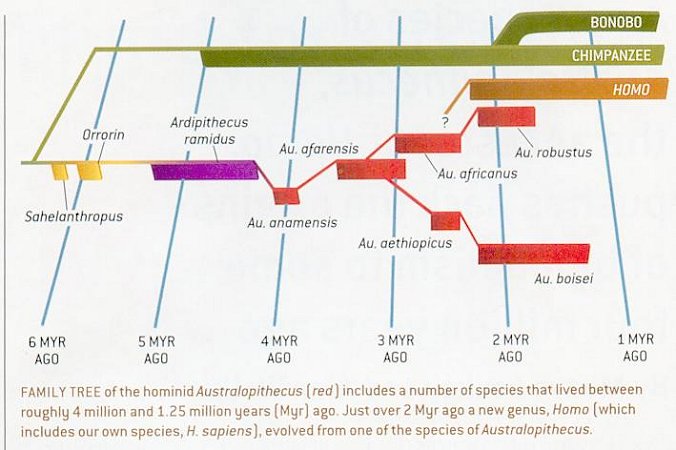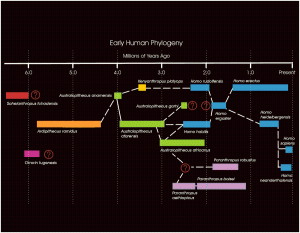Species, how did they form?
A species is a group of organisms which can mate and and produce fertile offspring. Evolution says different species came from common ancestors and result from genetic mutations.
We all know that different things can develop from a single source. One example: All of the different cells in your body came from one single zygote cell.
Evolution says a human and a chimpanzee are like skeletal muscle cells and heart muscle cells. They developed from the same source, but became different. They have similar traits, but they are different.
Cell differentiation from stem cells is something everyone believes in. No religious people claim that stem cells can not become different types of cells, yet, they do claim that humans (Homo Sapiens) and Chimpanzees can't possibly have a common ancestor. This is because our common ancestor was over 6 million years ago and a lot has changed in both species since then.
Here is another view (click to expand) which shows that Neanderthal was another species of
1) Human DNA determines how we look.
2) DNA damage inside our cells happens all the time and is continually repaired.
3) Some DNA damage can not be repaired and becomes permanent.
4) Genetic mutations are simply these non-repaired changes to our DNA.
5) Genetic mutations get passed on from cell to cell as our DNA is copied during cell division.
6) Genetic mutations get passed on from parent to child when broken DNA in parents is copied into their egg and sperm cells.
7) Conjoined twins are identical twins which come from a single egg and a single sperm. (They are monozygotic.)
8) If the zygote separates into two early enough, you get normal identical twins, but if separation fails to happen after the 13th day, conjoined twins result.
ome from Some DNA has the instructions for cell division, including the
Genetic mutations lead to different physical appearances.
7) Genetic mutations which get passed, over time, create new species.
Notes:
Identical twins result from tiny genetic mutations within a developing embryo that lead one portion of the embryo to reject the other as foreign, causing the two to split, a researcher proposed last week at a conference of geneticists. ... Judith G. Hail, a pediatrician and geneticist at the University of British Columbia in Vancouver, says she has found genetic dissimilarities between two twins that arose from the same fertilized egg. One twin has developed as a dwarf, while the other has attained normal height and body proportions, Hall reported at the Short Course in Medical and Experimental Mammalian Genetics at Jackson Laboratory in Bar Harbor, Maine. She hypothesizes that this difference resulted from a mutation in one part of the embryo that caused it to split, creating two different "identical" twins. ... geneticists have [also] recorded instances in which one of two otherwise identical twins has Turner's syndrome. - flib
Only about three pairs of twins per thousand deliveries occur as a result of natural conception. But for IVF deliveries, there are nearly 21 pairs of twins for every thousand. ... There are a lot of very subtle effects in the body, like different gas concentrations, enzymes or salt solutions - fox
Identical twins are also called "monozygotic" twins. Mono means "one" and a zygote is a single cell that is formed by the union of a sperm and ovum.
Both egg and sperm are gametes, special cells with one half a complete set of chromosomes. When the nuclei of gametes fuse, they form the zygote, which divides and then differentiates into different cell types.
The three times a zygote divides after being created form totipotent stem cells. In mammals, only the zygote and early embryonic stem cells are totipotent, that is, capable of becoming any other cell type.


No comments:
Post a Comment